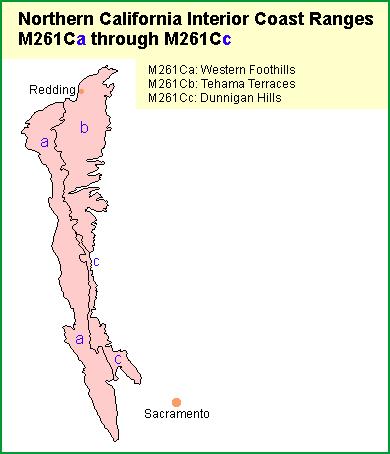 | Northern California Interior Coast Ranges |
|
|
http://www.fs.fed.us/r5/projects/ecoregions/m261c.htm
Northern California Interior Coast Ranges
This section is the southeastern edge of the northern California Coast Ranges mountains, south of Cache Creek, and hills and terraces along the west side and north end of the Sacramento Valley. It is in MLRAs 15 and 17.
Geomorphology. Parallel ranges, folded, faulted and metamorhosed strata; rounded crests of subequal height. Coast Ranges Geomorphic province.
Lithology. Late Mesozoic shelf and slope sedimentary deposits.
Soil Taxa. Alfisols, Inceptisols, Mollisols and Vertisols in combination with thermic soil temperature regime and xeric soil moisture regime.
Vegetation. Predominant potential natural communities include the Blue Oak series, Chamise series, Purple needlegrass series and Foothill pine series.
The following series are found throughout the section and are not restricted to or extensive in any subsection. Series dominated by exotic plants are not listed under subsections unless they are extensive and stable.
Series dominated by exotic plants: Cheatgrass series, Eucalyptus series, Tamarisk series.
Series that can occur in all subsections, but are not extensive: Bulrush series, Bulrush - cattail series, Cattail series, Creeping ryegrass series, Duckweed series, Mosquito fern series, Nodding needlegrass series, One-sided bluegrass series, Pondweeds with floating leaves series, Pondweeds with submerged leaves series, Purple needlegrass series. Saltgrass series, Sedge series, Spikerush series.
Series restricted to riparian settings: Arroyo willow series, Black willow series, Buttonbush series, Fremont cottonwood series, Mixed willow series, Mulefat series, Narrowleaf willow series, Pacific willow series, Red willow series, White alder series.
Fauna. Mammals include mule deer, black-tailed deer, coyotes, ground squirrels, cottontails, jack rabbits and kangaroo rats. Birds include turkey vultures, eagles, hawks, owls, quail, mourning dove, mockingbird, scrub jay, western meadow lark, finches and sparrows.
Elevation. 200 to 3000 feet.
Precipitation. 15 to 40 inches.
Temperature. 55░ to 62░ F.
Growing Season. 150 to 250 days.
Surface Water Characteristics. Many rapid perennial or intermittent streams in deeply incised canyons with weak bedrock channels flowing easterly to the Sacramento River. Reservoirs for irrigation water and flood control are common.
Disturbance Regimes.
Fire: Fires are low, moderate and high intensity surface or stand replacing fires.
Land Use. Composition and successional sequence of some communities has changed because of plant and animal species introduced between the mid 1800Æs and early 1900Æs related to grazing and agriculture.
Cultural Ecology. Humans have been utilizing the interior Coast Range foothills for 8,000 to 9,000 years, and have been an integral part of the ecology for 3,000 to 5,000 years. Historically, ranching and agriculture provided the primary Euroamerican livelihood. Contemporary attitudes and beliefs are dichotomized between emphasis on amenity/newcomer and commodity/long-time resident values, with all overlain by a rural lifestyle. Contemporary economic pursuits include government employment, agriculture, and recreation.
Subsections. The Northern California Interior Coast Ranges section is divided into 3 subsections.

